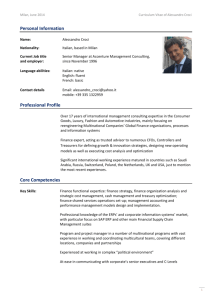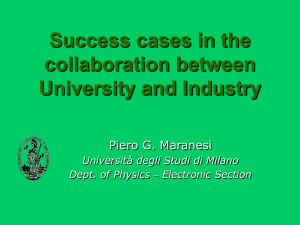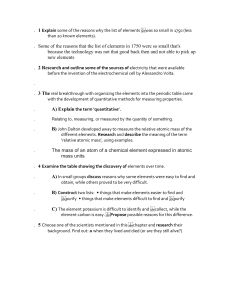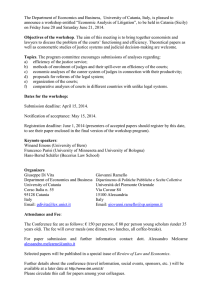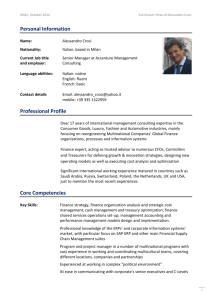Power Supply Report
advertisement
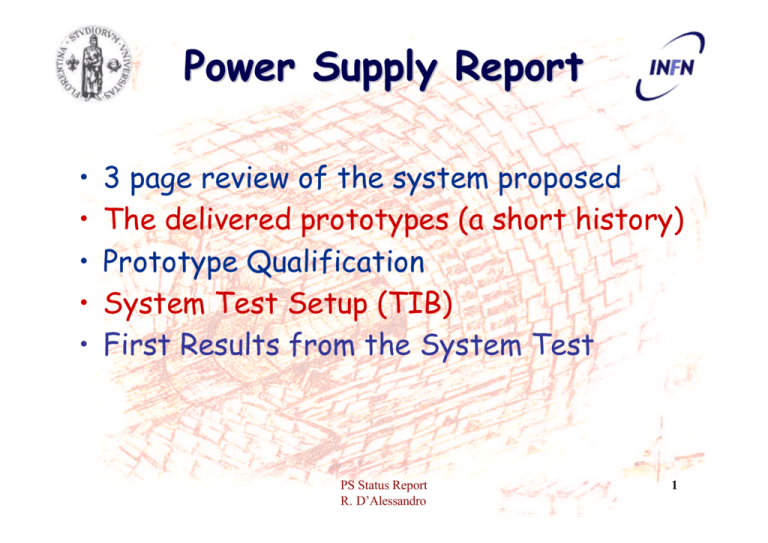
Power Supply Report • • • • • 3 page review of the system proposed The delivered prototypes (a short history) Prototype Qualification System Test Setup (TIB) First Results from the System Test PS Status Report R. D’Alessandro 1 Proposed System •Detector modules powered in parallel at a relatively long distance (~ 120 m) from the PS. –Group detectors together (up to 60 APVs) –Use sense wires to regulate voltages on the load (LV only) Implies •High Currents (10 Amps) •Relatively high voltage drops (4V) •Efficiency issues (variable loads) •Isolation at HF of the PS Why 120 m ? •Place PS in a “safe” environment •PS always accessible PS Status Report R. D’Alessandro 2 System Architecture Controller •A PSM houses 2-4 PSUs and their control logic. •PSMs share the +48 V supplied PSM by Power Units ( PU). •PSMs are grouped in crates (910 PSM/crate ) •The PSM rack ( PSM array ) is driven by one dedicated Controller, which is interfaced to the CMS Slow Control Power Unit PS Status Report R. D’Alessandro 3 The Prototype PSU • PWM (Switching PS) – (less power dissipation in the PSU) • 2 HV generators – (extra flexibility for detector biasing inside a given group) • Relay switches – (disconnect the cable from the PSU) • Low stray capacitance transformers – Improve HF isolation PS Status Report R. D’Alessandro 4 Short History (1) • Project given the go ahead 20th April 2000 • Prototypes ordered: – October 2000 (CAEN), December 2000 (LABEN) • First release: (many iterations between Fi and manufacturers) – June 2001 (CAEN), November 2001 (LABEN) • June 2001, Torino releases its test box • Prototypes returned to the manufacturers for rework concerning isolation, stability, behavior during transients PS Status Report R. D’Alessandro 5 Short History (2) • CAEN prototype back at the beginning of 2002, isolation improved plus other fixes • Given to Torino for testing (plus debugging of the test box) • April 2002, first results presented for CAEN (still some problems with transient behaviour) • May 2002, CAEN modifies prototype (shorter response time plus “crow bar”), LABEN delivers its revised prototype. PS Status Report R. D’Alessandro 6 Old Slide (May 2002) • LABEN prototype tested in Florence, CAEN in Turin (an exact repeat of the testing sequence performed on the earlier version with the Turin test box) • Both manufacturers readily answered queries and sent personnel to Turin and Florence to solve minor issues. The work done by both manufacturers is evident in the progress made both for what concerns the prototypes functionality and the over-voltage and over-current behaviour. PS Status Report R. D’Alessandro 7 Short History (3) • May 2002 LABEN takes prototype in Milan • June 2002, CAEN prototype back from Torino • July 2002, LABEN prototype back from the manufacturer In the meanwhile in Florence we have: •developed various cable prototypes •developed ( help from Torino) a fast switched load •assembled and debugged the first all optical + CCU25, silicon module readout PS Status Report R. D’Alessandro 8 CAEN prototype • • • • Based on existing SYxxxx solution ONE PSU per board (2 boards delivered) Prototype at the level of an evaluation board Software in good shape • • • • Developed from scratch TWO PSUs per board (2 boards delivered) Prototype at “final” engineering stage Software in its infancy (euphemistic) LABEN prototype PS Status Report R. D’Alessandro 9 CAEN prototype PS Status Report R. D’Alessandro 10 LABEN prototype PS Status Report R. D’Alessandro 11 Qualification (the procedure) • Use of “traditional” lab equipment • Gain an understanding of the measurement complexities • Appraise the performance of the PS prototypes • Subsequently use the Torino automated test fixture for detailed repetitive and/or long term measurements PS Status Report R. D’Alessandro 12 Qualification (the hardware) Laben crate The basics: • Static loads • MOS switched loads • LCR meter(s) • Digital scope(s) • Cables CAEN crate PS are floating ? • Careful screening • Well defined grounding • Differential measurements PS Status Report R. D’Alessandro 13 NOISE Measurements •BW < 20 MHz •Small capacitors 22 uF •Noise @ 6 Amps (2.5V) and 4 Amps (1.25V), depends very little on drawn current •Measurements shown are with 50 metre cable (ext. 12 mm) •Adding another 100 metre doesn’t change much (seems to have a beneficial effect) PS Status Report R. D’Alessandro 14 LABEN (LV Noise) PS Status Report R. D’Alessandro 15 LABEN (HV noise) PS Status Report R. D’Alessandro 16 LABEN (Transients 1.25V) PS Status Report R. D’Alessandro 17 LABEN (Transients 2.5V) PS Status Report R. D’Alessandro 18 LABEN (Isolation) PS Status Report R. D’Alessandro 19 LABEN (comments) • Stable behaviour (independent of load and cable length) • Noise, is it acceptable ? (Especially HV) • Transient behaviour generally very good (current limits, etc.); can the response time to voltage overshoots be bettered still ? • Isolation is impressive, capacitive behaviour showing an understood • Prototype designed with final engineering in mind • Software not only a problem of looks, but essential parts (like trip and ramping procedures) missing. (A. Bocci in Florence is working20 PS Status Report on it) R. D’Alessandro CAEN (LV noise, 2.5V) PS Status Report R. D’Alessandro 21 CAEN (LV noise, 1.25V) PS Status Report R. D’Alessandro 22 CAEN (HV noise) PS Status Report R. D’Alessandro 23 CAEN (Transients 1.25V) PS Status Report R. D’Alessandro 24 CAEN (Transients 2.5V) PS Status Report R. D’Alessandro 25 CAEN (Isolation) PS Status Report R. D’Alessandro 26 CAEN (comments) • “Stable” behaviour (except for the 1.25V which is dependent of load and perhaps cable length, but can be fixed) • Excellent Noise performance • Transient behaviour generally good (current limits, etc.) there is an exception in a “pathological” condition. • Isolation is good • Prototype designed as an evaluation board, not clear how it will scale to engineering stage and how the present performance depends on the eval. Board arch. • Software excellent, shows the great amount of work the company has put in general on PS systems. PS Status Report R. D’Alessandro 27 Where did we start from… •Noise, current limit, over voltage, a long learning curve for both manufacturers PS Status Report also for us. 28 and R. D’Alessandro General Comments • Prototype qualification is ONGOING • Results shown are the first, after the definition of a systematic approach in order to have a reproducible set of measurements • We will extend this approach to also include the Torino test box for repetitive and long term measurements Both prototypes substantially answer our specifications as stated in the various documents we produced. Can they be used for the system test ? YES! (with caveats) Above all the prototypes themselves need the system test in order to be further developed ! PS Status Report R. D’Alessandro 29 TIB system test • Not only for PS but “evolving” into a fully fledged mechanical and electrical test – NEEDS optical decoupling to achieve meaningful results • At first we needed a relatively good understanding of an optical system compared to a copper one: – Many measurements made (Marco Meschini talk, yesterday at the module test meeting) PS Status Report R. D’Alessandro 30 La bara DOH CCU25 PS Status Report Power distribution PCB R. D’Alessandro 31 La baruccia PS Status Report R. D’Alessandro 32 From Marco’s talk (1) • Front end APV25-s1 on FR4 hybrid, TIB module, 300 um thick 3 Lasers A.O. Hybrid 12 way optoreceiver PS Status Report R. D’Alessandro 33 From Marco’s talk (2) Short distance APV-AOH Final Kapton cable could be even shorter than this one Input/Output temporary connections on the back of module carrier PS Status Report R. D’Alessandro 34 What went inside • We placed a fixed resistor (5 Ohm value) on both LV lines • Modules/Hybrids connected through TIST: – Straight feed-through of the PS lines – CMOS buffering (same as used in final string) • 47uF + 100nF blocking capacitors (per Module) • HV filter (specially for LABEN, but used also with CAEN) PS Status Report R. D’Alessandro 35 What went outside • Industrial PC dedicated to this test – – – – – two FEDs one FEC one TSC one Digital Optical Transceiver one Analog Optical Receiver Plus a battery to supply 5 Volts to the Digital Opto-Hybrid and CCU ring ! PS Status Report R. D’Alessandro 36 Software • “Standard” Module Test software (Lyon) • Modifications for : – Laser driver (new version) – DOH, FEC – CCU 25 • The software works with two FEDs but can only address one I2C channel at a time •Allows direct comparison, with the module test suite PS Status Report R. D’Alessandro 37 Operating conditions • Inverter out • MUX 100 Ohms (15 setting) • AOH, gain 3, bias 18 (new LDD!), 50 Ohm termination • Standard M.Raymond parameters for the APV • 50 metre “internal” + 100 metre “external” cable, which transports also sense wires and HV lines • One common grounding point defined on the CCU ring (la bara is completely isolated from the “outside”) • The PS are in another room PS Status Report R. D’Alessandro 38 Inverter effect (old CAEN L3) Inverter out Inverter in PS Status Report R. D’Alessandro 39 All measurements refer to a hybrid and a full TIB module triggered and readout at the same time ADC counts The module and the hybrid survived ! TIB 09, 200V bias CAEN 150m ns PS Status Report R. D’Alessandro 40 Common Mode with CAEN TIB09 Deconv 200 V bias HV filter Peak ADC channels PS Status Report R. D’Alessandro ADC channels 41 Noise profile with CAEN TIB09, 200 V bias HV filter RMS/strip Deconv APV strip RMS/strip Peak PS Status Report R. D’Alessandro APV strip 42 Common Mode with CAEN (2) TIB09 Deconv 200 V bias NO! HV filter Peak ADC channels PS Status Report R. D’Alessandro ADC channels 43 Common Mode with LABEN TIB09 Deconv 200 V bias HV filter Peak ADC channels PS Status Report R. D’Alessandro ADC channels 44 Common Mode with LABEN (2), Inverter IN Deconv TIB09 200 V bias HV filter Deconv ADC channels In case you weren’t convinced ! PS Status Report R. D’Alessandro ADC channels 45 Noise profile with LABEN TIB09, Deconv RMS/strip 200 V bias HV filter APV strip RMS/strip Peak PS Status Report R. D’Alessandro APV strip 46 Noise profile Hybrid CAEN - LABEN LABEN RMS/strip The difference is the HV ! APV strip RMS/strip CAEN Deconvolution PS Status Report R. D’Alessandro APV strip 47 50 mV/div Hard Reset effects (1) CAEN,150 metre cable 2.5V-nores 1.25V-0.45Ohm 250 us/div PS Status Report R. D’Alessandro 48 50 mV/div Hard Reset effects (2) 1 ms/div 50 mV/div LABEN,150 metre 2.5V & 1.25 noresistors LABEN,150 metre 2.5V & 1.25 5 Ohm PS Status Report R. D’Alessandro 1 ms/div 49 Conclusions • We have started ! • PS work has given fruit to what we think is a viable option for the Tracker (next months will give a definite answer) • We will keep interacting with CAEN and LABEN to solve the remaining issues • The DAQ is stable, (no glitches, no spurious hard resets !) • Only two hybrids but ready to read-out up to 6 simultaneously PS Status Report R. D’Alessandro 50 Conclusions (2) This PS project is a collaboration between Florence and Torino The TIB system test between Florence and Pisa Thanks to a lot of people (a few names): – CERN (J. Troska, F. Vasey, S. Marchioro, C.Paillard, L. Mirabito) – Perugia (B. Checcucci, M. Brunetti) – Pisa (Roby Dell’Orso, R. Cecchi) – Torino (M. Costa, P. Trapani) Thanks also to F. Maletta, M. Brianzi, E. Scarlini PS Status Report R. D’Alessandro 51 System Architecture (1) PS Status Report R. D’Alessandro 52


